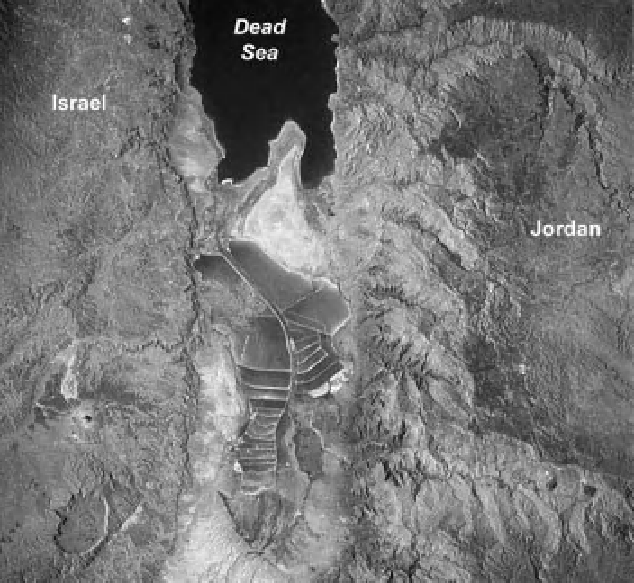Geoscience Reference
In-Depth Information
Figure 11-7.
Salt production pools at the southern end of the Dead Sea, Israel and Jordan. The evaporation ponds
are separated by a central dike running more or less north-south along the international border. Potash, bromine,
magnesium and other compounds are produced from the brine and salt. Image courtesy of K. Lulla, NASA Johnson
Space Center. Photo ID: STS28-96-065, August 1989.
• surrounding land use and settlement
patterns
• land ownership and tenure patterns.
conditions. These simple i shing techniques
require minimal capital inputs except for main-
taining the stone walls. Individuals pick stranded
i sh off the sand beach once tides have receded.
In most cases, such i shing techniques yield
small subsistence catches, and often are just sup-
plements to output from agricultural plots. In
other cases, i shing using small boats may yield
fairly large catches and serve local markets.
Small-scale rural farmers often use seasonally
l ooded wetlands as livestock grazing sites that
provide large quantities of fodder during the dry
season. Examples of these are observed in the
elevated shallow dambos of Zimbabwe or the
fadama of Nigeria (Turner 1984). Cattle ranching
in the vàrzea adjoining major rivers of central
Amazonia concentrates in the low-lying pastures
during drier periods and shifts to higher-
elevation cleared l oodplain forests during wet
periods ( Junk and Piedade 2005). Hay produc-
tion is another traditional use of wet meadows,
salt marsh, and seasonally l ooded sites (Fig.
11-9).
Hunting, trapping, foraging, and small-scale
i shing and agriculture are some of the oldest
activities carried out by humans in wetland envi-
ronments. Indigenous communities in many
parts of the world still depend on these activi-
ties and maintain their traditional knowledge
and technologies when extracting resources. For
instance, the Hudson and James Bay lowlands
of Canada include bogs, fens, and permafrost
peatlands (Abraham and Keddy 2005). Here,
indigenous communities of Cree, Dené and
Métis dominate this sparsely populated region
and still engage in i shing and hunter-gathering
activities (Birkes et al. 1994).
Small-scale i shing is common all along India's
coastal regions (Fig. 11-8). Often local i shing
communities clear sections of coastal mangroves
and construct low stone walls along shore-
lines which serve to trap i sh during low-tide





